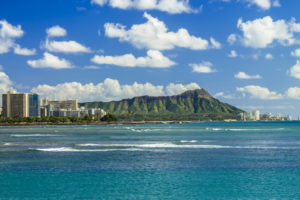Aloha! This month we travel west to the island paradise of Hawaii. In the state, you can attend a luau to experience true Hawaiian culture, relax on the beach or hike in one of the many tropical forests or mountains.
Hawaii is unique because it the only state made up of part of the volcanic Hawaiian archipelago, which consists of hundreds of islands spread over 1,500 miles. At the southeastern end of the archipelago are eight islands known as the state of Hawaii. They are: Niihau, Kauai, Oahu, Molokai, Lanai, Kahoolawe, Maui and Hawaii.
Due to its central location in the Pacific Ocean and its 19th-century labor migration, Hawaii’s culture is strongly influenced by North American and Asian cultures, in addition to its indigenous Hawaiian culture. This is exhibited by the many customs and food cuisines that the state has to offer. For example, it is customary to bring a small gift for one’s host (i.e., a dessert). Many Hawaiian plates have been influenced by Polynesian, Asian and American foods as well.
Business Climate
The history of Hawaii’s economy can be traced through a succession of dominant industries: sandalwood, whaling, sugarcane, pineapple, the military, tourism and education. The state’s exports include food and clothing. These industries play a small role in the state’s economy, due to the shipping distance to viable markets such as the West Coast of the contiguous U.S.
The state’s food exports include coffee, macadamia nuts, pineapple, livestock, sugarcane and honey. Hawaii’s consistent climate has attracted the seed industry, which is able to produce three generations of crops per year on the islands, compared with one or two on the mainland.
Due to the mild year-round weather, tourism is popular throughout the year. The major holidays are the most popular times for people to visit, especially in the winter months. Visitors flock to the many state parks that the state has to offer, including Diamond Head State Monument, Hanauma Bay State Underwater Park, Waimea Canyon State Park and Waimea River State Park. For a taste of Polynesian culture, people visit the Polynesian Cultural Center and for history, people visit the USS Arizona Memorial at Pearl Harbor. (December 7th, of course, is nationally recognized as Pearl Harbor Day.)
Tax Climate
Hawaii’s top individual income tax rate is 11%. The top corporate income tax rate is 6.4%.
Apportionment: Hawaii taxpayers apportion income using a 3 factor formula with sales, property, and payroll equally weighted.
In Hawaii, receipts from services are sourced based on the location of the taxpayer’s market for the service.
Sales Tax Structure – not exactly a sales tax!
The state levies a 4% general excise tax (GET), a tax similar to sales tax in other states but much broader in its application. Businesses are subject to GET on their gross receipts from doing business in Hawaii. A sales tax is a tax on customers whereas GET is a tax on businesses. Also, businesses are required to collect sales tax from their customers whereas businesses are not required to collect GET from their customers. However, in practice, most businesses DO collect the GET from their customers, which they are permitted to do. The average local sales tax rate is an additional 0.4%.
Sellers who lack physical presence nexus in Hawaii and have sales into the state that exceed $100,000 or who have more than 200 transactions for the current or previous calendar year must register and remit sales tax to the state. It is important to note that this threshold applies to taxable years beginning on January 1, 2018. Gross income or gross proceeds of tangible personal property, intangible property, or services delivered or consumed in the state are included in the threshold. Exempt sales and exempt services are also included in the threshold. This legislation went into effect on July 1, 2018.
A marketplace facilitator that has physical or economic nexus with Hawaii must collect and remit sales tax on all sales into the state, including those by an unlicensed seller. Marketplace sellers may be liable for Hawaii general excise tax (GET) in some situations. This law went into effect on January 1, 2020.
With Hawaii’s growing economy, it is a popular state for out-of-state businesses to sell their products to in-state customers. Prewritten software that is downloaded electronically is taxable. Additionally, custom software that is downloaded electronically is taxable. Software-as-a-Service appears to be taxable. Generally, digital products in Hawaii are also taxable.
Many states have annual sales tax holidays, during which certain items the state wants to promote the purchase of (like school supplies emergency preparedness supplies, or energy efficient appliances) can be purchased sales tax free. Hawaii, however, does not currently have any scheduled sales tax holidays.
Our team at Miles Consulting Group is always available to discuss the specifics of your situation, whether in Hawaii or other U.S. States, and help you navigate the complex tax structures arising from multistate operations. Call us to help you achieve the best tax efficiencies.
Random Facts
- The state’s coastline is 750 miles long, the fourth longest in the U.S. after the coastlines of Alaska, Florida and California.
- It is the 8th smallest and the 11th-least populous state, but the 13th-most densely populated of the 50 states.
- Hawaii’s tallest mountain, Mauna Kea, is 13,796 feet above sea level. If measured from the base of the mountain, which lies on the floor of the Pacific Ocean, the mountain is about 33,500 feet tall, which is taller than Mount Everest.
- Hawaii is the only state where coffee is grown.
- Hawaii is the only state to have never recorded a sub-zero Fahrenheit temperature.
- The Hawaiian alphabet has 12 letters: vowels- A, E, I, O, U; consonants- H, K, L, M, N, P, W.
- More than one-third of the world’s commercial supply of pineapples comes from Hawaii.
- From east to west, Hawaii is the widest state in the United States.
- The big Island of Hawaii is the largest of the islands at 4,038 square miles. It is twice the size of all the other Hawaiian Islands combined.




















